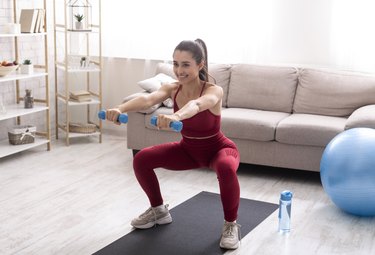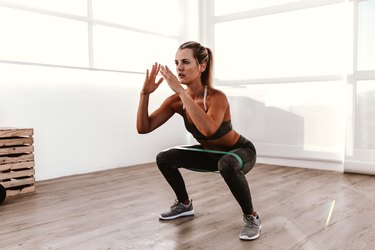
Learning how to increase your vertical jump offers plenty of on-the-court advantages. Want to dunk like a boss or defy gravity to get a game-winning volleyball spike? It's time to up your jump training.
And with the right strategies, you can increase your vertical jump by 20 inches in a matter of months. After that, the sky's the limit.
Video of the Day
The key: honing your technique, strength work and plyometric training.
"You combine those three things, that's your formula to success," says Brian Singh, a jump specialist for collegiate and professional athletes and creator of the Vertical Jump Program.
Simply fixing your jump technique can add 2 to 3 inches to your max jump, Singh says, and doing targeted strength and plyometric training should net you another 2 to 3 inches per month. Here, Singh breaks down exactly how to increase your vertical jump for volleyball, basketball or whatever sport you're training to dominate.
Learn Proper Vertical Jump Technique
Perfecting your technique is one of the quickest ways to add inches to your vertical jump. Depending on how quickly you get the hang of technique, you may see these performance benefits within one day to one month.
Practice your technique 3 to 4 times per week for max gains. And follow these basic tenets:
- Build speed going into your jump and don't let up until your feet land.
- Maintain a straight line from the build-up to the jump; don't zigzag or side-step along the way.
- Use your arms to help you launch off the ground.
Check out the tutorial below to learn the optimal jump technique.
Vertical Jump Technique Explainer
- Find an open area where you have room to run a few steps and then jump up high. You should have a clear path that allows you to move in a straight line.
- Begin standing at one end of your movement pathway. Then run forward a few steps (or as many steps as the space allows), increasing your speed as you go.
- Keep building speed as you near the end of your movement pathway. Without pausing or slowing down, explosively drive through your legs. Quickly extend your hips, knees and ankles.
- Land with your knees bent, then walk back to the starting line.
The 2 Best Plyometric Jump Drills to Increase Vertical Jump
It goes without saying: If you want to jump higher, you need to train your jump on a regular basis. And the best way to do that is through plyometrics, or jump training.
Plyometric exercises, like depth jumps, box jumps and jumping lunges, target your fast-twitch muscle fibers. These are the muscle cells responsible for powering quick, explosive movements (like jumping).
Move 1: Seated Vertical Box Jump
- Begin seated on a short box or step with your knees bent and feet flat on the floor. Have a sturdy, taller box or step in front of you, but make sure there’s a little space in between the two platforms for you to jump over.
- Stand up and, without pausing, explode upward. Use your arms to help you propel yourself and jump both feet onto the taller box or step.
- Land softly on the taller box with your knees bent.
- Step back down.
- Do 3 to 4 sets of 6 to 8 reps.
Tip
Gradually increasing the height of the box by 1 or 2 inches at a time can help you to progress toward your goal of increasing your vertical jump by 6 to 14 inches. But make sure you're able to jump and land on the box using proper form before you advance to a higher height.
Move 2: Depth Jump
- Begin standing on a short box or step. Have a sturdy, taller box or step in front of you, but make sure there’s plenty of space in between the two platforms.
- Step off the short box or step so you’re directly in front of the taller box or step.
- The moment your feet make contact with the ground, explode upward. Use your arms to help you propel yourself and jump both feet onto the taller box or step.
- Land softly on the taller box with your knees bent.
- Step back down.
- Do 3 to 4 sets of 6 to 8 reps.
Tip
“If you go into the gym and you’re not being as explosive as you should be, that means you need to stop and spend more time on recovery,” Singh says.
Similarly, if your power drops during your workout, take it as a sign that your fast-twitch muscle fibers have hit their limit. Pushing the plyo will only activate your slow-twitch (endurance) muscle fibers and decrease the height of your jumps in the long run, Singh says.
The 3 Best Strength Exercises to Increase Vertical Jump
Catching air is a hip-dominant feat of strength. As such, building strength in your hips through exercises like squats, deadlifts and hip thrusts will go a long way toward helping you maximize your jump power.
That's because they're compound exercises, which mean they engage more than one muscle group at a time. Along with increasing strength, compound exercises train different muscle groups to work together, just as the quadriceps, calves, hamstrings and glutes do during a vertical jump.
These three exercises, performed using barbells, dumbbells or kettlebells, are all compound exercises that can help to increase your strength for jumping.
Tip
Perform a dynamic warm-up — consisting of jogging, jumping rope, knee lifts and single-leg hops — for 5 to 10 minutes before training. Perform strengthening exercises 2 to 3 days a week, doing 2 to 3 exercises per muscle group. Complete 3 sets per exercise. Use resistance levels that allow you to complete at least 8 but not more than 12 reps with proper form.
Move 1: Back Squat
- Duck under the bar and position yourself so that it rests high on the back of your shoulders. Make sure the bar rests on the meaty party of your shoulders, not on your neck, and grasp it on either side for stability.
- Stand up beneath the bar to take its weight on your legs. Step back into the squat rack/squat cage so that the bar will clear the racking pins, and set your feet shoulder-width apart. Adjust your position, if necessary, so that you're stable and balanced.
- Bend your knees as you move your hips back and down as if you were sitting in a chair behind you. Your torso will tilt forward from your hips, but keep your back straight.
- Lower until your thighs are parallel with the ground (or as low as you can comfortably squat while maintaining good form).
- Press through your feet to reverse the motion and return to standing.
- Do 3 to 4 sets of 6 to 8 reps.
Move 2: Barbell Deadlift
- Fix the weight plates on your barbell and position it on the floor in front of you. If needed, position it on an elevated platform to allow for a reduced range of motion.
- Step up to the bar, shins almost against it, feet planted firmly hip-width apart. Keep your spine straight, chest up and shoulders back and down.
- Hinge from the hips, softening your knees as your hips sink low enough so you can grasp the bar with your hands shoulder-width apart.
- Check your posture: Your spine should be straight and long, chest up and open and shoulders back.
- Engage all the muscles of your core to maintain this position as you push your feet into the floor. Imagine that you are trying to push the floor away from you, and stand up.
- Finish the motion by lifting your chest and engaging your lats to stabilize the bar in front of your hips.
- Return the bar by reversing the motion, pushing your weight back into your hips and softening your knees, letting the bar travel in a controlled path back down to the floor along your body.
- Do 3 to 4 sets of 6 to 8 reps.
Move 3: Barbell Hip Thrust
- Sit on the ground with the bottom of your shoulder blades on the edge of an exercise bench or box.
- Extend your legs out in front of you and roll a barbell up over your hips, placing a cushion underneath the bar for comfort if needed.
- Bend your knees and place your feet flat on the ground.
- Keeping your neck long, press into your heels and raise your hips off the ground, lifting the barbell up. As you bridge up, your neck and shoulders should move onto the bench.
- Pause here for a moment, then lower back down.
- Do 3 to 4 sets of 6 to 8 reps.
Don't Neglect Your Core Muscles
Incorporating exercises that target your abdominal muscles, lower back, pelvis and hips into your training program can help your body to remain balanced and stable when jumping. A variety of crunches on a stability ball, bicycle crunches and reverse crunches will work your abs.
Supermans, planks and bird-dogs can help to strengthen your lower back and the transverse abdominis, which is the deep-seated abdominal muscle. Side planks with a leg lift can work your hips.
Move 1: Bicycle Crunch
- Start lying flat on your back with your hands behind your head. Contract your lower abs to raise your legs a few inches off the ground.
- Twist your torso and bend your left knee so that your right elbow crosses your body and reaches toward your left knee.
- Switch and twist to the other side so that your left elbow reaches toward your bent right knee.
- Keep alternating sides without tucking your chin toward your chest.
Move 2: Plank
- Lie face down on the floor, with your forearms on the ground, elbows directly beneath your shoulders.
- Extend your legs straight behind you, toes tucked.
- With your core braced, press into your toes and forearms and raise your body up off the ground.
- Keep your back flat and your body in a straight line from head to hips to heels.
Move 3: Side Plank
- Start lying on your side, propped up on your bottom forearm. Your elbow should be directly under your shoulder to avoid putting too much pressure on the joint. Your legs should be extended straight out with your feet stacked one on top of the other.
- Lift your hips off the ground. Make sure that your hips are squared forward. Keep your body as straight as possible from heels to hips to head.
- Hold this position for as long as you can with good form.
How Often Should You Do Jump Training?
When it comes to vertical jump training, more isn't always more. Both plyometric and heavy strength exercises create a lot of muscle damage and neurological fatigue in a relatively short period of time. To jump higher, you have to give your muscle fibers and nerves a chance to rebuild, so they can grow back stronger and more explosive.
"A lot of the gains happen when you're recovering, and you need to recover more than you train," Singh says.
Ideally, you'd train 3 to 4 times per week, making sure to take a day off in between sessions. With this schedule, you could strength train 1 to 2 days per week and perform plyometrics on 1 to 2 other days.
In theory, you could work on your technique as often as you'd like, but 3 to 4 days per week is sufficient. "My athletes do technique work before or after their plyo and strength training sessions," Singh says.


